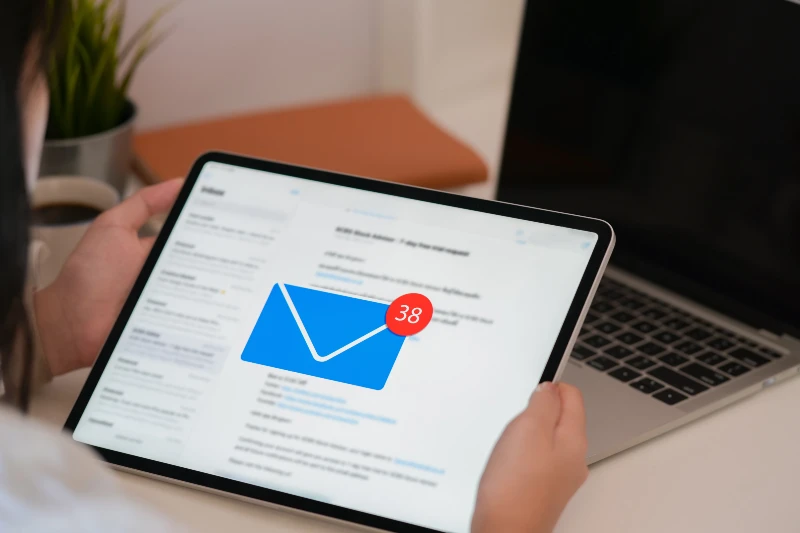Email marketing is an often overlooked gem in inbound marketing strategies.
As a marketing manager, you know that SEO and social media marketing are key components of your inbound marketing efforts, but perhaps you’re wondering if email marketing is truly worth your time and investment.
Well, let’s see how email marketing plays a big role in your overall inbound strategy.
1. Send to Targeted People
One of the strongest advantages of email marketing is its ability to speak directly to those who have already shown interest in your product or service.
Unlike other marketing methods that scatter their messages far and wide, email allows you to tailor your communications to a select audience, people who have willingly subscribed to hear from you.
This direct line of communication ensures that your content reaches those more likely to engage with it, since these individuals have opted in because something about your product, service, or content resonated with them initially.
You can further create segments within your email lists and craft target messages. For example, crafting offerings suited to different demographics, purchase histories, or engagement levels.
This personalized approach not only enhances your message’s relevance but also significantly improves your chances of converting leads.
2. Improve Communication
Your ability to communicate effectively with your audience paves the way for building stronger relationships with your customers. Email marketing excels in this role, extending a bridge of continuous dialogue between your brand and your subscribers.
Through a well-structured email campaign, you can deliver consistent and valuable information, which will keep your brand at the forefront of your customers’ minds.
Whether it’s a regular newsletter, updates on industry trends, or educational content, these communications help to establish your brand as a go-to resource in your field.
Moreover, the two-way nature of email allows for feedback and interactions – through surveys, replies, or personalized follow-ups – which can give rise to a more profound understanding of your customers’ needs and preferences.
3. Nurture Leads
As you know, nurturing leads is a delicate and crucial step in the inbound marketing process, one that email marketing handles with finesse. From the moment a potential customer shows interest by subscribing to your email list, you have the opportunity to guide them along their customer journey.
Automated email campaigns can provide leads with a series of touchpoints that offer value and gently prompt them towards making a purchase.
For example, you might begin with a welcome email that thanks them for subscribing, followed by a series of emails that introduce your company, share valuable insights, or offer exclusive content.
These drip campaigns keep leads warm by continuously engaging them, ensuring that your brand stays relevant in their decision-making process.
As leads move further down the funnel, email content can become more tailored to their specific interests or behaviors, sending targeted offers or content that addresses their pain points.
This strategy requires a deep understanding of your audience’s needs at each stage of the buyer’s journey and a thoughtful approach to content creation.
4. Increase Website Traffic
A key goal of any inbound strategy is to drive qualified traffic to your website, and email marketing is a powerful conduit for achieving this.
By including compelling calls-to-action (CTAs) and links to your website within your emails, you can encourage subscribers to visit your site to learn more, read your blog posts, or check out your latest products.
You can use email campaigns to highlight new content, product launches, or special promotions, enticing subscribers to click through to your website.
To maximize these visits, make sure that the landing pages your emails link to are optimized for engagement.
They should be relevant to the email content, compelling, and offer a straightforward path for visitors to take the next step, whether it’s making a purchase, signing up for an event, or downloading a resource.
5. Offer Personalized Engagement
Personalized engagement goes beyond simply addressing an email recipient by their first name. It’s about delivering content that is relevant to their interests, behavioral patterns, and stage in the customer lifecycle.
Advanced email marketing tools can track subscriber behavior, allowing you to segment your audience and deliver highly personalized content.
You can tailor your emails based on past purchases, content that they’ve engaged with, or even demographic data. For instance, sending a discount code to a customer on their birthday can add a special touch that makes your brand memorable.
Or, if they’ve abandoned their shopping cart, a follow-up email with a special discount for the items they left behind may encourage them to complete the purchase.
Personalized emails resonate with recipients because they feel understood and valued as individuals, not just as part of a mass audience.
This type of targeted engagement can dramatically increase the relevance and effectiveness of your marketing efforts, leading to higher click-through rates, increased sales, and stronger customer loyalty.
6. Regular Reach
Consistency is key in staying top-of-mind with your audience. People check their email multiple times a day — it’s the first thing many do in the morning and the last activity before they sleep.
If you can maintain a consistent email schedule, you can ensure that your brand remains visible to your customers.
Whether you choose to send emails daily, weekly, or monthly, consistency will help build a routine with your subscribers, setting expectations for when they’ll hear from you next.
7. Control Over Messaging
In a digital landscape where algorithms can unpredictably change your marketing reach overnight, email marketing offers a unique degree of control over your messaging.
Unlike social media platforms where your content’s visibility can be at the mercy of platform changes, your email list is your domain, where you make the rules.
With email marketing, you decide on the content, the timing, and the audience, allowing you to tailor messages that directly reflect your brand’s voice and goals.
This level of control ensures that your messaging remains consistent and that your marketing efforts are insulated from external disruptions. You can execute finely-tuned campaigns that reach your audience without the interference of third-party gatekeepers.
8. Re-Engagement of Inactive Customers
Every brand has them—customers who once engaged with your products or services but have since turned inactive. Email marketing provides an effective means to reactivate the interest of these customers.
Through targeted reengagement campaigns, you can remind these individuals why they were drawn to your brand in the first place and tempt them back with updates, special offers, or helpful content that they may have missed.
Crafting the right message for re-engagement involves understanding why these customers may have disengaged. Was it a lack of communication, relevance, or simply an oversight?
Tailoring emails that address potential reasons for their inactivity and presenting solutions or incentives can pave the way for their return.
9. Send Promotional Content:Products, Services, Discounts, Events,
Promotion is a fundamental part of marketing, and email offers a direct and effective channel to inform your subscribers about new products, services, discounts, and events.
A well-timed promotional email can boost sales, attract participants to events, and keep subscribers informed of what’s new and exciting about your brand.
With email marketing, you control the narrative around your promotions, making it easier to coordinate with other aspects of your overall marketing strategy.
Whether it’s a seasonal sale or a launch of a new product line, you can craft your promotional emails to complement your social media campaigns, blog content, or in-store events, creating a cohesive experience for your customers across all channels.
10. Tell Subscribers About and Industry Trends
Email marketing also allows you to educate your subscribers about your industry, share insights on trends, and position your brand as a thought leader. When you offer valuable information, not just sales pitches, you build trust and credibility with your audience.
In this way, you increase the likelihood that subscribers will turn to you when they’re ready to make a purchase, because you’ve already proven your worth and knowledge in the field.
For instance, share case studies that showcase how your products or services have solved real-world problems, or provide insightful analysis on how emerging trends could impact your subscribers’ businesses or personal lives.
These educational emails not only reinforce your expertise but also encourage subscribers to share your content with their networks, extending your reach and potentially growing your email list with new, interested contacts.
11. Guide Customers Through Their Purchase Journey
Email marketing can also actively guide subscribers through every stage of their purchase journey. With targeted content that addresses the specific questions and concerns at each funnel stage, you can effectively move leads to buyers.
For those at the top of the funnel, your emails should aim to educate and inform. As they move down the funnel, your content can gradually shift to more product-focused information, testimonials, and strong calls-to-action that compel subscribers to take the leap from consideration to purchase.
After a purchase is made, follow-up emails can encourage feedback, offer post-purchase support, and even suggest complementary products, which can enhance the customer experience and foster loyalty.
12. Increase Customer Satisfaction and Retention
Email marketing can keep customers happy and engaged post-purchase.
Customer satisfaction is a cornerstone of any thriving business, and through email communication, you can provide continuous support, gather customer feedback, and ensure that customers feel valued long after they’ve made a purchase.
Personalized follow-up emails thanking customers for their purchase can create a positive post-sale experience and set the foundation for a lasting relationship.
You can also use email to check in with customers, asking them about their product experience or offering helpful tips on how to make the most of their purchase.
Additionally, by segmenting your email list based on purchase history or behavior, you can send targeted emails that cater to individual customer needs, whether it’s offering replenishments for products that are likely to run out soon or suggesting products that complement ones they’ve already bought.
These thoughtful interactions not only enhance customer satisfaction but also increase the chances of repeat purchases and long-term retention.
13. Increase Brand Loyalty
Email marketing can help foster your brand loyalty by creating an emotional connection with your customers, and is an ideal platform for building and nurturing this connection.
Loyalty programs can be effectively managed through email marketing, offering special rewards, points, or benefits for frequent shoppers which can be highlighted and tracked through personalized emails.
Share stories of how your brand aligns with certain values and causes that resonate with your audience to deepen the emotional bond.
Celebrating customer milestones is another strategy to increase loyalty. For instance, on the anniversary of a customer’s first purchase or after a set number of purchases, acknowledge their loyalty with a special thank you note or an exclusive offer.
Small gestures like these build a reciprocal relationship where customers feel appreciated and are more likely to stay loyal to your brand.
14. Lead to Higher Conversions and a Return on Investment
At the end of the day, your inbound strategy should aim to boost conversions and deliver a strong return on investment (ROI).
Email marketing, with its low cost and high potential for personalization, is renowned for its ability to drive conversions through direct, targeted messages that guide subscribers towards taking action.
In fact, email marketing often boasts one of the highest ROI rates across various marketing channels, partly due to its direct nature and the control it offers in crafting and delivering messages.
By continuously testing and analyzing email campaigns, you can optimize for better performance, adjusting elements like subject lines, email copy, design, and CTAs to see what resonates best with your audience and drives conversions.
You can pay attention to key metrics such as open rates, click-through rates, and conversion rates to understand how your emails are performing.
From there, you can refine your approach, focusing on what works and eliminating what doesn’t. This might involve A/B testing various aspects of your emails to see what tweaks can lead to improved effectiveness.
Conclusion
In your role as a marketing manager, you can leverage the power of email marketing to complement and enhance your existing inbound strategies.
As you can see, its synergy with other channels like SEO and social media adds another layer of depth to your marketing efforts, creating a resilient ecosystem that thrives on customer engagement and satisfaction.
To sum it up, email marketing isn’t just an addon to your inbound marketing, it’s a driver of it, fueling each component from lead generation to customer retention. Embrace email as a fundamental part of your strategy, and watch as it propels your inbound marketing to new heights.





